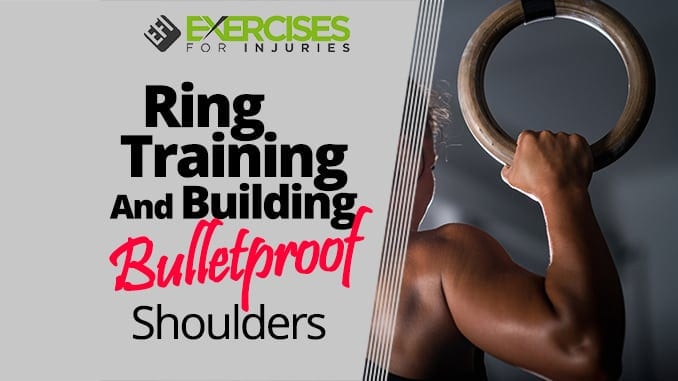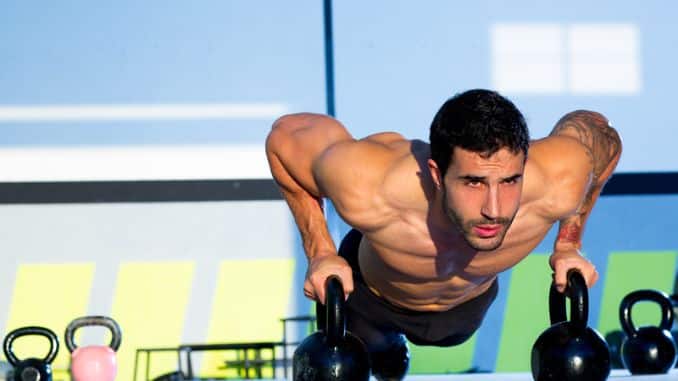
You may have heard it before, but posture does matter. In everything we do, from lifting weights to everyday activities, posture affects our muscles and performance. Keeping a proper posture [¹] not only looks good but also protects your body from injury. Bulletproof shoulders are a must for anyone looking to take their training to the next level, with visible and measurable results.
A common question I get asked from Fix My Shoulder Pain customers is what to do about ring training and shoulder pain.
I am not a ring-training guy, but Tyler Bramlett is.
He took on the question and had some great info to help you out.
Enjoy.
~ Rick
Training on the rings is one of the most challenging ways to strengthen your upper body.
If you never had a chance to work on the gymnastic rings, you may be shortchanging the results you’re getting from your workout.
Shoulder & Elbow Pain And Gymnastic Rings
Many people are concerned about bulletproof shoulders or elbows using gymnastic rings. Still, as long as you know the correct sequence of exercises, you can safely practice the gymnastic rings and build a solid pair of shoulders.
If you’re not sure whether or not ring training works, all you have to do is look at how strong, powerful, balanced, and coordinated gymnasts are to make moves like iron crosses, handstands, and even just perfect supports on the gymnastic rings. So why aren’t you taking advantage of gymnastic ring training?

Most people don’t take advantage of training with gymnastic rings because they’re incredibly challenging to get started on. I would bet big money that you rarely run into a trainer that understands how to coach the rings and where you should get started to build Bulletproof Shoulders.
The bottom line is most people don’t understand movement progressions, and this lack of understanding prevents them from becoming a better coach and getting better results in their workouts. You MUST use proper movement progressions when tackling the beast called ring training!
So where the heck do you start?
How To Prevent Injuries On The Rings
How do you prevent injuries?
And How do you use the rings to build resilient and robust bulletproof shoulders?
Well, you’re in luck! I will teach you a specific series of exercises that you can use progressively on yourself and your clients to build a solid and resilient upper body [²].
Every great gymnastic coach understands the idea behind movement progressions and how they can benefit your training if you’re patient and focused.
Movement Progressions And The Rings
Think about it like this, the first time you walk into the gym, the only thing they let you do with the gymnastic rings is bodyweight-only rows or bodyweight ring push-ups.
Over time, you build competency on these two exercises and move up to a progressively harder movement. Things like ring dips and pull-ups become your new playing field, and over time you can build from starting at bodyweight rows and bodyweight push-ups on rings to doing exercises like muscle-ups, front rolls, front levers, back levers, presses to handstands, and eventually moves like the iron cross, all injury-free with Bulletproof Shoulders.
But if you are too impatient, training on gymnastic rings can be dangerous if improperly coached. Here’s a blueprint to get you started using the gymnastic rings to build massive amounts of upper body strength you cannot make any other way.
I hope to teach you a clear progression that I have used successfully with dozens of clients to teach you the most popular ring exercises that most people want to be able to accomplish, the muscle-up.

Muscle Up Exercise And The Rings
A muscle-up starts in a hanging position below the rings and moves your body to a support position above the rings with strength and control.
If you’re entirely new to the rings, it’s not wise to jump into attempting your first muscle-up.
I have a specific progressive system that you can use to get started on your ring training, which contains three different steps before attempting your first muscle-up.
But first, you need to know a trick called the false grip.
The picture below details what the false grip should look like as you have your hands on the gymnastic rings.
This will allow you to eventually move your body from underneath to above the rings without the hassle of changing your grip. It is the essential piece of the puzzle if your goal is to get better at ring training.
If you’re a complete beginner, start with these beginner-level exercises.
False Grip Bodyweight Ring Row
The first exercise is the false grip bodyweight ring row. Grab onto the rings with a false grip on the handles and pull your hands into your armpits as deep as possible. Repeat for 3-5 sets of 10 or more reps.
1. Ring Push-up

The second exercise is the ring push-up. Place the rings about 1 foot above the ground and in a push-up position. Try to keep your body nice and still as you go through a full range of motion. Be sure to stay bulletproof; shoulders pulled back at the bottom not to cause shoulder impingement. Repeat for 3-5 sets of 10 or more reps.
Once you can get multiple sets of 10 reps in the false grip ring row and full range ring push-up, you can move on to the intermediate exercises.
2. False Grip Ring Pull-up & Ring Dip

The intermediate exercises practiced the false grip ring pull-up and the ring dip.
For the false grip, the ring pull-up grabs onto the rings and maintains a false grip throughout the movement. Pull your body up towards the rings imagining that you’re trying to bring your elbows closer to your hips (this will help involve your core more).
Aim for your hands below your collarbones or as deep of a pull-up as possible. Try to perform three sets of 8 reps while maintaining the false grip the entire time.
For the ring dips, place the rings at a height where you can jump up to ring support. If this is your first time jumping up to ring support, keep your hands tight to your hips, trying to keep your knuckles against your hips the entire time. This way, you will prevent yourself from flailing about in coming down from the ring support.
Come up to the support position and descend as you can while maintaining perfect control. You must possess excellent authority because if you wobble in a low ring support position, you can cause harm to your shoulder.
3. Full-Range Ring Dips
A great way to work into full-range ring dips is to perform a progressive range of motion dips. Try to perform three sets of 8 reps in a full range of motion. Come down as far as you feel 100% comfortable and then come back up; over time, you can go through a more extensive range of motion until you can do a full range of motion ring dips without any problem to your shoulders. One final thought is to think about always pulling your shoulder blades back as you come into the bottom position of the ring dip. This will put your shoulders in a better and safer place.
Once you get three sets of 8 reps in the false grip pull-up and full range ring dip, you can move on to the advanced exercises.
For the advanced ring, exercises practice jumping through muscles up to the top position and then coming down with a slow negative.
Start by standing under the rings and maintaining a false grip with your hands. From there, jump through to a low dip position keeping the rings tight to your body. Press up to a support position and then, as slowly as possible, try to come to a full hang position. Be sure to take your time working on this exercise for sets of 1 to 3 reps.
Once you can do several slow and controlled muscle-up negatives in a row, attempt your first full muscle-up.
How To Perform First Muscle-up Grasp

To perform your first strict muscle-up, grasp the rings with a false grip and be sure to maintain it the entire time. Pull your body up as high as possible, so your knuckles are below your collarbone. From there, trace your chest muscles with your thumbs coming from the center to the outside as you transition from the top of the pull-up to the bottom of the dip. From there, press up to a support position at the bottom of the drop, and you have completed your first muscle-up! This is the most challenging part of the muscle up and will require some practice.
Once you have completed your first muscle-up, work on getting single reps for more sets. If you can get one repetition the first time, the next week, try to get two repeats, and the week after that, try to get three and then four and then five, and then finally work your way up to be able to do several muscle ups in a row in a full range of motion. From there, the sky’s the limit, five reps of a strict muscle up in one set, or you can add more weight to your muscle up, making it even more challenging.
Another way to progress even further is to choose more challenging exercises on the rings using the progressive movement method. You can do things like front levers, back levers, front rolls, or back rolls.
Conclusion
Bulletproof shoulders are critical for optimal performance in any athletic pursuit. Suppose you want to improve your lifting capabilities, increase your overall strength, or be able to do more in daily activities. In that case, a solid workout routine focusing on the shoulders is necessary. While many exercises can help build muscular shoulders, the ones outlined in this article are the most efficient.
The rings are undoubtedly one of the most significant ways to increase your balance, upper body strength, and coordination. At the same time, this is why they’re so effective at building some of the most muscular bodies in the world!!
Take your training slow, and you will benefit significantly from using the gymnastic rings in your workouts.
Tyler Bramlett
Here are a few other articles from Tyler:
- Importance of Movement Progressions for Post Surgery Knee Recovery
- Goblet Squat as a Gluteus Maximus Exercise
Unlock a Pain-Free Life! Discover the secret to overcoming shoulder pain with Shoulder Pain Solved. Our proven strategies and expert guidance can help you regain full mobility and live without discomfort.

